Dave of the Five Rings is an ongoing series chronicling David Gordon’s return to the Legends of the Five Rings CCG after several years. He will be tracking his progress from the launch of the game’s new core set, Ivory Edition, through to the season’s culmination at GenCon 2014.
Chapter 1: Once More Unto the Breach
After a couple years away, I have returned this spring to playing the Legend of the Five Rings CCG. It has been a long and complicated path that has led me to this point, and it is through this series of articles I plan to explore the experience of returning to a game I have played for over sixteen years. Through these articles, I will explain my history with L5R, as well as my view on playing it competitively and my own history of competitive play. I will examine the current environment and walk through the process of creating my current deck. I will write my impressions of competitive play on both the local tournament scene and at the national qualifier tournaments, called Kotei. Finally, I will end this series with my experiences playing Legend of the Five Rings at GenCon, and how this time has changed me. First, however, I must provide some context.
Unlocking The Power Of The Rings
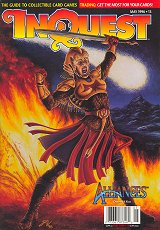 I began playing the Legend of the Five Rings CCG in junior high in the mid 1990’s. I had read about the game in a copy of InQuest magazine and expressed my interest in it to my friendly local gaming store in Barton, Vermont. They had no real desire to order it, but on a trip to Burlington, I found the game in stock at Quarterstaff Games down on Church Street.
I began playing the Legend of the Five Rings CCG in junior high in the mid 1990’s. I had read about the game in a copy of InQuest magazine and expressed my interest in it to my friendly local gaming store in Barton, Vermont. They had no real desire to order it, but on a trip to Burlington, I found the game in stock at Quarterstaff Games down on Church Street.
Growing up a gamer in northeastern Vermont was a strongly formative experience on me, and I credit my entire style of how I approach games to that unique environment. I actively sought out games like Legend of the Five Rings, games that while available in select stores, were not the guaranteed hits that Magic: the Gathering had already become by that time. Similar to Second Edition Dungeons & Dragons, I invested in Legend of the Five Rings enough to supply decks to my friends. I was even eventually able to convince the gaming store in the far closer St. Johnsbury to buy some boxes of starters and boosters.
Through this diligence, I fostered a small group of a half dozen gamers, playing the CCG on weekends and summer afternoons after chores. (To the best of my knowledge, the group vanished when I moved away for high school in Massachusetts.) Nevertheless, I was already comfortable playing and teaching L5R by the age of sixteen. I eagerly read the descriptions of the Day of Thunder world championships at GenCon 1998, and I immersed myself in the rich culture of L5R. Towards the end of my high school days, I became active with the Deathseeker.com community as well as the Wizards of the Coast online groups. I followed the game through its time at Wizards of the Coast, volunteering for their website and being paid in credit for their online store – which invariably was spent on L5R cards.
As a game, Legend of the Five Rings had held my interest due to both its strongly Asian-flavored fantasy aesthetic, and its intricately tactical play mechanics. Written to exploit factionalism from its very root, L5R caters to the player who wants to feel part of something greater. The idea that you are a warlord of one of several Clan-based factions fighting a war for glory and rule, combined beautifully with mechanics that were tailored to each faction. In a way, it’s like taking the colors of Magic and giving them entirely different play styles and themes, then letting the players of the various colors win prizes in an ongoing, living world described in the story.

L5R players built communities first and foremost, and that sense of community filled the entirety of the game. L5R players truly cared about the world we played in, and we felt a sense of connection with both our opponents and our allies. One such anecdote I am still proud of sharing regarding this communal atmosphere by L5R players comes from the community of Deathseeker.com during the 9/11 attacks.
As our community shook with the news of the events of that morning, Deathseeker.com became more than simply an L5R news site. It became a focal point of organization for charitable acts. Blood drives were started, online charities sprung up, and by the end of the day, there were over 20 tournaments organized around the world with all proceeds going to the Firefighters and Police charitable organizations of NYC. When faced with tragedy, we pulled together as a community and did something awesome. I am still proud of those days in that community, and I always will be.
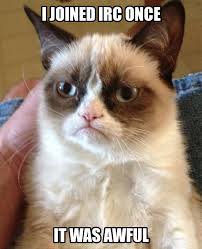 It was not until college, however, that I truly began to play Legend of the Five Rings competitively. Before then, it had never really been a viable option. Convincing friends to play meant stealing time away from Magic and D&D. Similarly, playing online through Gempukku and other clients meant stalking chat rooms and IRC channels of dubious nature. While the former option kept my passion for the game alive, and the latter allowed me to face players I had only read about in gaming magazines, neither truly compared to that first tournament.
It was not until college, however, that I truly began to play Legend of the Five Rings competitively. Before then, it had never really been a viable option. Convincing friends to play meant stealing time away from Magic and D&D. Similarly, playing online through Gempukku and other clients meant stalking chat rooms and IRC channels of dubious nature. While the former option kept my passion for the game alive, and the latter allowed me to face players I had only read about in gaming magazines, neither truly compared to that first tournament.
Rising and Falling With Naga
All Legend of the Five Rings players get attached to their factions. I would even call it a feature of the game, and it’s one of the best parts of playing it.
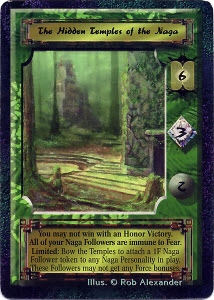 My first starter deck had been the Hidden Temples of the Naga in 1996, and I had played the faction through all its various permutations. The Naga were an ancient race of half-serpent people who were the non-evil outsiders to the xenophobic samurai of Rokugan. They had awakened millennia after the collapse of their once great society to do battle with an ancient and terrible evil, and instead came into conflict with strange, angry monkey-people who now dominated their land.
My first starter deck had been the Hidden Temples of the Naga in 1996, and I had played the faction through all its various permutations. The Naga were an ancient race of half-serpent people who were the non-evil outsiders to the xenophobic samurai of Rokugan. They had awakened millennia after the collapse of their once great society to do battle with an ancient and terrible evil, and instead came into conflict with strange, angry monkey-people who now dominated their land.
The Naga were fascinating to me, and I embraced the stories of how Naga players in tournaments would refuse to fight each other because “Naga do not war with Naga.” Supposedly, players would simply build up their armies until the game time was called, and the player with the smaller army on the table would concede to the other.
The Naga were strange, different, and noble. They were, however, ultimately never very successful in the tournament scene and were not central to the samurai-focused narrative of L5R. As such, they were removed from the game with the introduction of Gold Edition in 2001.
In a bit of irony, by the time I played in my first truly competitive Legend of the Five Rings environment, the faction that had been mine from the beginning was gone. I had been a Naga player, and they had been cycled out after ownership of L5R returned to Alderac Entertainment Group. Without the faction that had been mine for nearly six years, I had a perspective on L5R that still separates me from many other players. In a game centered around in-group / out-group factionalism, I was ultimately homeless. And that made me different.
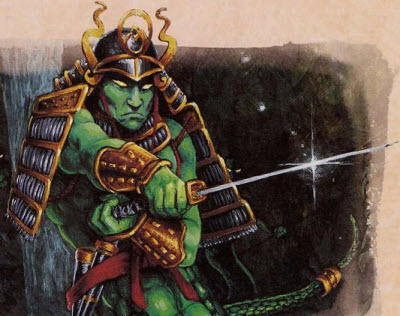 As with many disenfranchised players from the six factions that had been cut, I cast about in the early Gold Edition environment for a new deck to play. Some pointed me towards the Mantis Clan for their bevy of ranged attacks, which were formerly a Naga theme. Others pointed me towards the Crab for their hatred of the Shadowlands, also formerly a focus of the Naga. Neither held my interest.
As with many disenfranchised players from the six factions that had been cut, I cast about in the early Gold Edition environment for a new deck to play. Some pointed me towards the Mantis Clan for their bevy of ranged attacks, which were formerly a Naga theme. Others pointed me towards the Crab for their hatred of the Shadowlands, also formerly a focus of the Naga. Neither held my interest.
Ultimately, I began playing Phoenix Clan, running a tight military blitz deck out of the Towers of the Asako. I relied on a personality base that were almost entirely boxable, and a gold scheme that relied on free Gold producing holdings in the form of Corrupt Silver Mines, Corrupt Iron Mines, Small Farms, and Mining Foremen. I ran force pump actions, cheap followers, and relied on my Stronghold to protect my samurai. It was dubbed the Shiba Counterattack deck after I won an important tournament game by crushing all four of my opponent’s provinces during a single Counterattack after playing Shiba Technique in my only surviving province. I played this deck through most of Gold, but it never made it out of the pack in the tournament scene.
Washing Upon The Shore
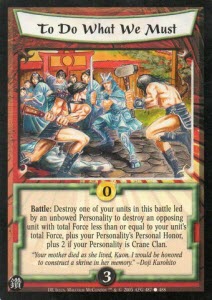 With Diamond Edition, I stayed playing Phoenix out of an appreciation for their theme more than any storyline loyalty. I examined the environment and found an interesting set of cards that focused on defensive attrition. To Do What We Must, Mountains of the Phoenix, and Overwhelmed all allowed me to sacrifice my own personalities to destroy opposing military forces. When combined with the Morning Glory Castle’s ability to recycle your own dead personalities and Phoenix’s high personal honor, I created a defensive honor runner focusing on killing my own personalities for glory and military advantage.
With Diamond Edition, I stayed playing Phoenix out of an appreciation for their theme more than any storyline loyalty. I examined the environment and found an interesting set of cards that focused on defensive attrition. To Do What We Must, Mountains of the Phoenix, and Overwhelmed all allowed me to sacrifice my own personalities to destroy opposing military forces. When combined with the Morning Glory Castle’s ability to recycle your own dead personalities and Phoenix’s high personal honor, I created a defensive honor runner focusing on killing my own personalities for glory and military advantage.
While I only met with limited success in the tournament scene, I enjoyed a different aspect of it. My deck became somewhat notorious in our greater circle of play for its sheer zest at mutually assured destruction. It was unlike nearly anything else in the environment, and while Diamond never shifted in a way that favored my deck, it was fun to play.
I left the competitive scene for a half a year with the release of Lotus Edition, only returning to it at the urging of several friends. Once again, I was drawn back to the game by the prospect of playing something strange. I returned to with the release of the Orochi Sensei for the Mantis Clan. It seemed oddly fitting that I got my start playing serpent people with bows, and I was returning to play people with bows riding giant sea serpents. I had my best tournament record playing Orochi Sensei off of the Castle of the Wasp, losing out a spot in the New England Kotei’s top eight in a mirror matchup in the top sixteen.
The latter half of the Lotus arc, however, was dominated by the Unicorn Clan, and my Mantis kaiju just could not keep up. I migrated over to Lion Clan for Samurai Edition, running a Lion Clan military blitz that was several chase rares from being competitive. After I went five losses and zero wins at a Kotei in 2009, my desire to play L5R competitively was severely shaken. I attended the L5R scene at GenCon for the first time in 2009, but I failed to place positively in the eight hour long qualifying tournaments with a Mantis archery deck. It was the nail in the coffin, and I walked away from competitive L5R after that.
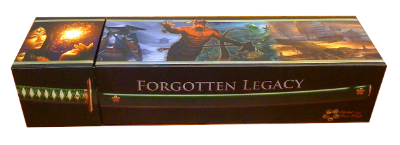
Yet, once again I was pulled back in during the Celestial Edition arc with the release of Forgotten Legacy. A direct-to-players boxed set, Forgotten Legacy featured the release of a new Stronghold and several Naga cards. It was enough for me to take it to GenCon in 2011, playing a deck that was more filled with monsters than the Naga which had originally drawn me to the game. While a deck using my Stronghold and nearly all the same cards took the tournament, a series of bad matchups lead to me scrubbing out of the qualifiers.
I did play in two Draft tournaments for L5R, however, going undefeated through both, and I was fortunate enough to spend Saturday evening of the convention playing cards with many of the game’s design team and the higher end competitive players. Unbeknownst to me at the time, it proved to be a fitting sendoff, for it was the last time I played the Legend of the Five Rings card game.
Before this year.
And now, here I am, ready to take the plunge once again. Next time, I address my impression of the fledgling Ivory Edition and my first feeble steps towards returning to competitive play.
David Gordon is a regular contributor to the site. A storyteller by trade and avowed tabletop veteran, he also has a long and complicated past with L5R. These are his stories. He can be reached at dave@cardboardrepublic.com.
You can discuss this article and more on our social media!
Photo Credits: InQuest magazine cover by Magic Libraries; Naga by Wikia; Grumpy IRC by Memecrunch; All other artwork by AEG.
